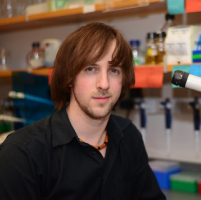Mitochondrial DNA Evolution: New Study Reveals How Selfish mtDNA Evolve and Thrive
By Andy Flick, Evolutionary Studies scientific coordinator

Vanderbilt University researchers, led by alumnus Bryan Gitschlag, have uncovered groundbreaking insights into the evolution of mitochondrial DNA (mtDNA). In their paper in Nature Communications titled “Multiple distinct evolutionary mechanisms govern the dynamics of selfish mitochondrial genomes in Caenorhabditis elegans,” the team reveals how selfish mtDNA, which can reduce the fitness of its host, manages to persist within cells through aggressive competition or by avoiding traditional selection pressures. The study combines mathematical models and experiments to explain the coexistence of selfish and cooperative mtDNA within the cell, offering new insights into the complex evolutionary dynamics of these essential cellular components.
Gitschlag, an alumnus of Vanderbilt University, conducted the research while in the lab of Maulik Patel, assistant professor of biological sciences. He is now a postdoctoral researcher at Cold Spring Harbor Laboratory in David McCandlish’s lab. Gitschlag collaborated closely with fellow Patel Lab members, including James Held, a recent PhD graduate, and Claudia Pereira, a former staff member of the lab.

According to Patel, “in biology, ‘cheater’ is defined as an entity that benefits from a cooperative relationship without reciprocating. Selfish mtDNA are bona fide cheaters in this sense. They benefit from their symbiotic relationship with the nucleus, by being replicated using machinery expressed in the nuclear genome, but without conferring the usual metabolic advantages associated with being a mitochondrial genome.”
Experimental Studies
The study centered on mtDNA in Caenorhabditis elegans, a tiny nematode that has long served as a model organism in genetic research. With its simple structure and fully mapped genome, C. elegans provides an ideal system for exploring the dynamics of mitochondrial DNA, including the balance between selfish and cooperative genetic elements. A key focus of this research was the uaDf5 mutation, a deletion in the mtDNA that behaves selfishly by outcompeting healthy mitochondria, even though it reduces the overall fitness of the organism.
This discovery has wide-reaching implications for the study of mitochondrial diseases, many of which arise from dysfunctional mtDNA. Understanding how selfish mitochondrial elements evolve and persist offers new pathways for investigating mitochondrial disorders and developing therapeutic interventions. Additionally, these findings provide a framework for studying similar evolutionary dynamics in other systems where selfish and cooperative elements coexist.
Mathematical Models
The mathematical model developed by the team helps explain how the uaDf5 mutation in mtDNA persists despite reducing the organism’s fitness, shedding light on how similar defective DNA might contribute to aging and disease. Following up, the team used this model to study other instances where mutations in mtDNA, which damage important genes, continue to persist and spread within cells, despite their harmful effects. The next step was to apply the model to other mtDNA mutations.
The researchers found that some mutations persist over time due to a balance between selection pressures operating both within and between individual organisms (multi-level selection), while other mutations persist due to a balance between selection pressures operating entirely within an organism. The paper suggests that mutations that have no effect would typically either become lost or become fixed in the population by random genetic drift. Accordingly, their model revealed that some mutations confer a net replicative advantage over unmutated (wildtype) mtDNA, causing the mutant mtDNA to proliferate within individual organisms. However, since this tends to occur at the expense of organism fitness, natural selection favors organisms with fewer copies of mutant mtDNA, enabling the mutant genome to stably persist through multi-level selection. Alternatively, some mutations provide a small but meaningful advantage that quickly disappears as mutant copies rise in number, becoming outcompeted by the wildtype mtDNA.
Surprisingly, the researchers found that the levels of mutant mtDNA are distributed among individual carriers in different ways depending on the underlying selection pressures at play. This serves to illustrate how evolutionary theory can offer insights into a broad class of genetic disorders for which there currently exists no cure. Since the severity of effects of a mutation depend on its relative abundance within an individual (which in turn depends on the evolutionary forces at work), understanding these population-genetic behaviors provides a potential window into predicting the risk of developing mitochondrial disorders from population data.
According to Patel, “our study represents one of the most rigorous applications to date of the evolutionary concept of multilevel selection. This concept refers to the idea that natural selection operates not only at the level of individuals but also at multiple levels of biological organization.”
Gitschlag concluded, “despite its theoretical significance, it has proven extremely challenging to empirically measure selection in isolation at different levels. Ours is one of the first studies to achieve this feat. Thus, what is super exciting about our work is that we believe it will stand the test of time and hope that it becomes a classic in the field.”
Citation: Gitschlag, B.L., Pereira, C.V., Held, J.P., McCandlish, D.M. & Patel, M.R., 2024. Multiple distinct evolutionary mechanisms govern the dynamics of selfish mitochondrial genomes in Caenorhabditis elegans. Nature Communications. 15: 8237.
Funding Statement: This work was supported by the NIH research project grants R01 GM123260 and R35 GM145378 (Patel). Discovery Award (PR170792) from the Department of Defense’s Congressionally Directed Medical Research Program (Patel), the Vanderbilt University Medical Center Diabetes Research and Training Center Pilot & Feasibility Grant (Patel), the NIH-sponsored Cellular, Molecular and Biochemical, and Molecular Sciences Training Program (5T32GM008554-18, Gitschlag), the Ruth L. Kirschstein National Research Service Award Individual Predoctoral Fellowship (1F31GM125344, Gitschlag), R35 GM133613 (McCandlish), an Alfred P. Sloan Research Fellowship and additional funding from the Simons Center for Quantitative Biology and Cold Spring Harbor Laboratory (McCandlish).
